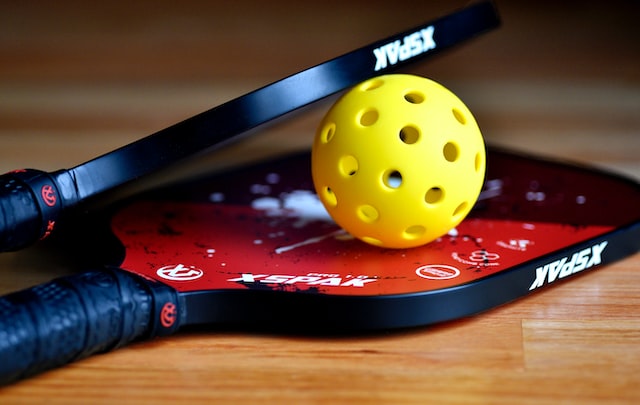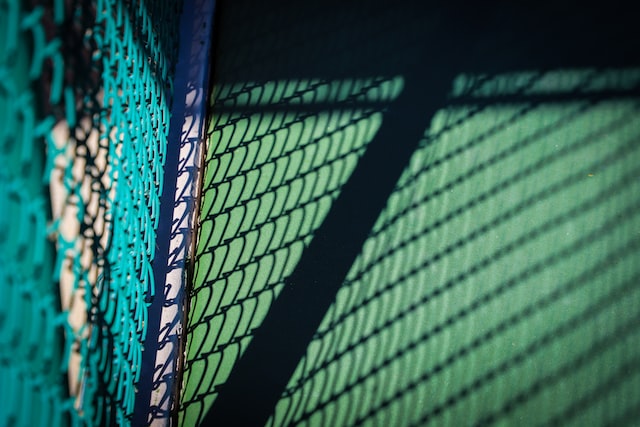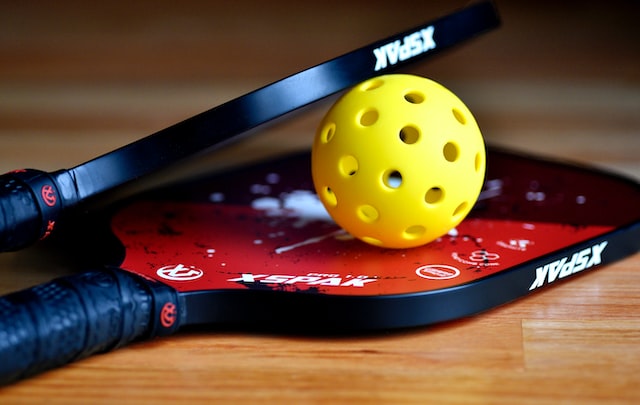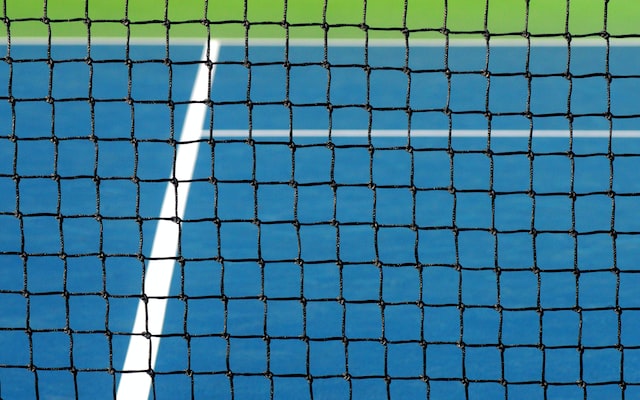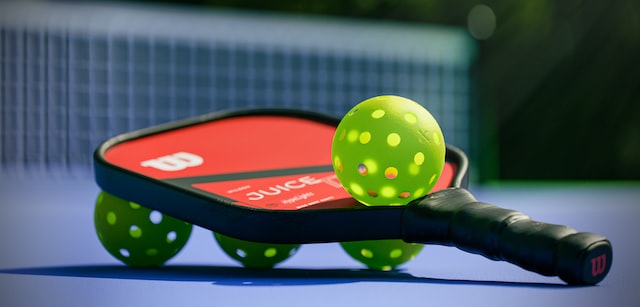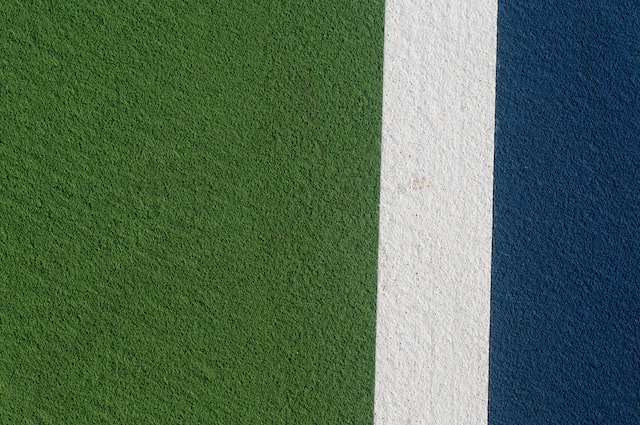7 Pickleball Shots That Every Player Needs To Know
There are some affiliate links below, but they are all products I highly recommend. For more info, view my disclosure here.
Pickleball is one of the fastest growing sports in the world today. Whether you’re a novice pickleball player or a seasoned pro, mastering the game requires knowing how to execute all seven essential shots. Read on to learn how to master these shots and take your game to the next level!
The first shot every player needs to understand is the serve. A good serve sets up your entire game and can give you an edge over your opponent. Understanding when to use different types of serves – from high-arcing lobs to low-trajectory power serves – can make all the difference in a match.
The second shot that’s essential for every player is the dink shot. Dinking allows you to keep your opponent off balance by playing short, soft shots that are difficult for them to return. Mastering this technique will allow you to control the pace of play and keep your opponent guessing about where you’ll go next.
Overview Of Pickleball Shots
Pickleball is a fast-paced and exciting game that requires quick reactions and strategy. As such, it’s important for players to know the various shots they can use to increase their chances of winning. There are a few key shots that every pickleball player needs to understand in order to maximize their performance on the court.
One shot that all players need to be familiar with is the dink. This shot is used to keep your opponent off balance by hitting a soft, low-bouncing shot just over the net. It’s important to try and hit this shot with both power and accuracy so your opponent isn’t able to get momentum from it.
The drop shot is another essential pickleball move, as it’s designed to make your opponent run and tire themselves out. With this shot, you aim just over the net but not too high – your goal is to have it land within reach of your opponent but require them to move quickly in order to return it. Drop shots should be used sparingly throughout a game, as they can be risky if read wrong by your opponents.
These two shots are just some of the many available for pickleball players looking for an edge on the court. All players should take time away from playing games in order to practice these shots so they can become second nature when needed during match play.
Forehand Groundstroke
Moving on from the overview of pickleball shots, let’s focus on the forehand groundstroke. This is one of the most important shots in pickleball and mastering it can be a game-changer. It’s all about finding your sweet spot and getting comfortable with your body.
The first step in mastering the forehand groundstroke is establishing your grip. Your grip should be comfortable and you should be able to maneuver the paddle easily. To do this, you want to find a spot where your thumb and index finger are closest together on the edge of the handle. The rest of your hand should wrap around it firmly but still comfortably enough for you to move freely.
Next, you’ll need to practice your stance for this shot. You should stand side-on to the net, with your feet slightly wider than shoulder-width apart and knees slightly bent – this will give you more power when hitting the ball. Then focus on keeping your upper body still while using only your arm and wrist to hit the ball back over the net. With practice, this shot will become second nature before long!
Backhand Groundstroke
The backhand groundstroke is a key shot in the game of pickleball. It can be used to hit the ball from either side of the court, and is important for defending against your opponent’s shots. To perform a proper backhand groundstroke, you should start by standing in an athletic stance with your feet shoulder-width apart. Make sure to keep your body balanced and have your dominant hand further back than your non-dominant hand. As you make contact with the ball, swing slightly toward the non-dominant side of your body while maintaining a low center of gravity. This will help you generate more power while still keeping control over the shot.
When hitting a backhand groundstroke, it’s important that your follow through is correct. After making contact with the ball, make sure to continue your swing until both arms are fully extended on each side of your body. This will help you maintain balance and generate more power when hitting the ball. Additionally, be mindful of how high or low you hit the ball and where it lands on the court; this will give you an advantage over your opponent as they have less time to react to where it goes next.
For maximum effectiveness, practice using different speeds on your backhand groundstroke shots so that you can keep opponents guessing during play. Additionally, it can be beneficial to practice different types of spin such as topspin or slice so that you can surprise opponents with unexpected placement and direction changes when playing pickleball. With enough practice and focus on technique, mastering this shot will give any player an edge during their next match.
Volley
The volley is one of the most important pickleball shots to know. It’s used to keep the ball in play and can be a great way to put pressure on your opponent. To hit a successful volley, you need to make sure that you’re standing close to the net, ready to make contact with the ball as soon as it comes your way. As soon as you see the ball coming, move your paddle up towards it and hit it with a flat surface. Make sure your grip is firm but not too tight so that you have enough control over where you hit it.
When striking a volley, you want to make sure that you are hitting it at an angle away from your opponent. This will give them less time to react and put them at a disadvantage. You also want to focus on minimizing any unnecessary movements and keeping your arm straight when making contact with the ball. This will help ensure that all of your energy is being directed into the shot rather than being wasted by excessive movement.
Finally, practice makes perfect when it comes to volleys so don’t be afraid to get out there and work on this shot until you feel comfortable with it. There’s no substitute for experience so take advantage of every opportunity you get!
Serve
The serve is a critical element of the game of pickleball. It’s the first shot in every point, so it’s important to have a good serve. The most important thing to remember when serving is to keep your wrist loose and relaxed. A loose wrist will ensure that you get more power and accuracy on the ball.
There are two main types of serves: underhand and overhead. An underhand serve is easier to master, as you don’t need to use as much power or aim for a specific spot on the court. An overhead serve requires more skill, as you must be able to hit the ball with enough force while aiming for a particular spot on the court.
Whether you choose an underhand or overhead serve, practice is key. Spend some time each day hitting serves from different angles and locations on the court in order to become a better player. With enough practice, you’ll be able to hit powerful and accurate serves consistently, giving you an edge over your opponents.
Overhead Smashes
Overhead smashes can be one of the most powerful shots in pickleball. It’s important to know how to perform this shot correctly and efficiently. Firstly, you need to make sure your body is in the right position. You should be standing with your feet slightly wider than shoulder-width apart and bent at the knees. Your non-dominant arm should be extended outwards while your dominant arm is bent, ready to strike the ball.
Secondly, it’s essential that you hit the ball at its apex – when it’s highest point – as this will give you more power and accuracy. When striking the ball, make sure you keep your arms straight and that your wrist is cocked back so that you can generate enough force for a successful smash.
Finally, it’s important to ensure that you follow through properly after hitting the ball. This means keeping your arms extended and following through with your swing until after the ball has been hit. Doing this will help maximize your shot’s speed and accuracy. By mastering these steps, you’ll be able to perfect overhead smashes in no time!
Drop Shots And Dinks
Now that you know how to master the overhead smash, let’s move on to the drop shot and dink. The drop shot is a great way to surprise your opponent and get them off-balance. It involves hitting the ball with a downward motion from midcourt, so that it lands close to the net and bounces only once before going out of bounds. The dink is also a surprise shot that can be used near the net. It’s a short, soft hit just over the net so that it barely goes over and drops quickly.
Both of these shots are difficult to execute because they require precision timing and positioning. You need to make sure you have enough backswing when hitting a drop shot, or else your opponent will be able to return it easily. When hitting a dink, you must take care not to hit it too hard or too soft – you want it just right! It takes practice but eventually you will learn exactly how much power to use for both shots so that they become part of your game arsenal.
Once you master these shots, you’ll be able to surprise your opponents with unexpected moves that they weren’t expecting – giving you the advantage in any pickleball match!
Lob Shots
Lob shots are an essential part of any pickleball player’s arsenal. This shot is perfect for those times when your opponent has you on the defensive, and you need to give yourself some time to reposition. It has two main components: a high arching trajectory, and a deep landing point.
To execute a successful lob shot, your body positioning is key. You’ll want to be standing slightly farther back from the baseline than normal, as this will allow your arm and racket to generate more power. As you swing, make sure to keep your elbow in and limit your follow-through for maximum control. The key here is to create a high arc that lands deep behind the service line.
The lob shot can be tricky for beginners, but with practice it’ll become second nature. To get the most out of this shot, focus on maintaining proper form with each stroke and visualize where the ball should land before striking it. With enough practice, you’ll soon gain confidence in your lob shots and be able to use them effectively against opponents in matches.
Defensive Shots
Defensive shots are crucial for a successful pickleball game. They enable the player to remain in control and keep their opponents from scoring. The three main defensive shots are the lob, the deep dink, and the block.
The lob is used to move your opponent away from the net and give yourself more time to prepare for their next shot. It requires hitting the ball high over your opponent’s head, with enough spin so that it lands within bounds on their side of the court. The deep dink is used when your opponent is at the net and you need to hit the ball back in a controlled manner. This shot can be hit sharply or softly depending on how much power you want behind it. Finally, the block is used when your opponent hits an aggressive shot towards you. This shot involves returning a hard-hit ball back with minimal effort; it allows you to stay in control while taking away your opponents’ advantage.
By mastering these defensive shots, players can better command their pickleball court and gain an edge over their opponents.
Strategies For Improving Your Shot Selection
Improving your shot selection takes practice and dedication. To improve, you must keep track of the shots you make and the shots you miss. This will help you to identify which shots work best for you. You should also think about why certain shots are not working, so that you can make an effort to fix them.
If a particular shot is failing, try to find out why by looking at its trajectory and speed. If the ball is not travelling in a straight line or going too slow, consider changing your grip or stance for better control. Practicing with a partner can also be beneficial; they can help pinpoint what aspects could be improved upon in order to increase accuracy and power.
In addition to physical technique, it’s important to focus on mental preparation. Visualizing successful shots before playing them can give you added confidence when executing them on the court. It’s also helpful to stay focused on the game and try to maintain a positive attitude in order for your shots to be more effective. With proper practice, your improved shot selection will soon become second nature!

